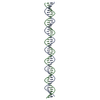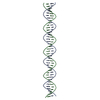+Search query
-Structure paper
| Title | KSHV but not MHV-68 LANA induces a strong bend upon binding to terminal repeat viral DNA. |
|---|---|
| Journal, issue, pages | Nucleic Acids Res, Vol. 43, Issue 20, Page 10039-10054, Year 2015 |
| Publish date | Nov 16, 2015 |
 Authors Authors | Rajesh Ponnusamy / Maxim V Petoukhov / Bruno Correia / Tania F Custodio / Franceline Juillard / Min Tan / Marta Pires de Miranda / Maria A Carrondo / J Pedro Simas / Kenneth M Kaye / Dmitri I Svergun / Colin E McVey /    |
| PubMed Abstract | Latency-associated nuclear antigen (LANA) is central to episomal tethering, replication and transcriptional regulation of γ2-herpesviruses. LANA binds cooperatively to the terminal repeat (TR) ...Latency-associated nuclear antigen (LANA) is central to episomal tethering, replication and transcriptional regulation of γ2-herpesviruses. LANA binds cooperatively to the terminal repeat (TR) region of the viral episome via adjacent LANA binding sites (LBS), but the molecular mechanism by which LANA assembles on the TR remains elusive. We show that KSHV LANA and MHV-68 LANA proteins bind LBS DNA using strikingly different modes. Solution structure of LANA complexes revealed that while kLANA tetramer is intrinsically bent both in the free and bound state to LBS1-2 DNA, mLANA oligomers instead adopt a rigid linear conformation. In addition, we report a novel non-ring kLANA structure that displays more flexibility at its assembly interface than previously demonstrated. We identified a hydrophobic pivot point located at the dimer-dimer assembly interface, which gives rotational freedom for kLANA to adopt variable conformations to accommodate both LBS1-2 and LBS2-1-3 DNA. Alterations in the arrangement of LBS within TR or at the tetramer assembly interface have a drastic effect on the ability of kLANA binding. We also show kLANA and mLANA DNA binding functions can be reciprocated. Although KSHV and MHV-68 are closely related, the findings provide new insights into how the structure, oligomerization, and DNA binding of LANA have evolved differently to assemble on the TR DNA. |
 External links External links |  Nucleic Acids Res / Nucleic Acids Res /  PubMed:26424851 / PubMed:26424851 /  PubMed Central PubMed Central |
| Methods | SAS (X-ray synchrotron) / X-ray diffraction |
| Resolution | 3.8 Å |
| Structure data |  SASDAM8:  SASDAN8:  SASDAP8:  SASDAQ8:  SASDAR8:  PDB-5a76: |
| Chemicals |  ChemComp-MG: |
| Source |
|
 Keywords Keywords |  DNA BINDING PROTEIN / DNA BINDING PROTEIN /  DNA / DNA /  VIRAL / VIRAL /  PROTEIN FOLDING / PROTEIN FOLDING /  PROTEIN STRUCTURE / PROTEIN STRUCTURE /  TERTIARY / TERTIARY /  RHADINOVIRUS / RHADINOVIRUS /  VIRAL PROTEINS / VIRAL PROTEINS /  VIRUS LATENCY VIRUS LATENCY |
 Movie
Movie Controller
Controller Structure viewers
Structure viewers About Yorodumi Papers
About Yorodumi Papers





